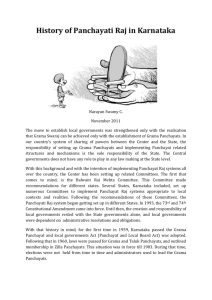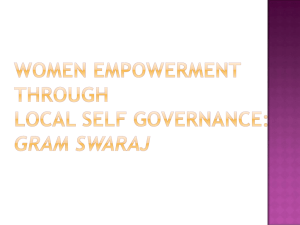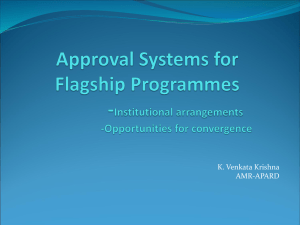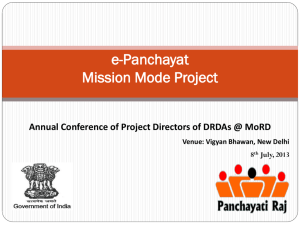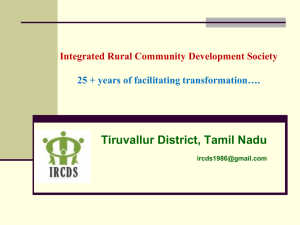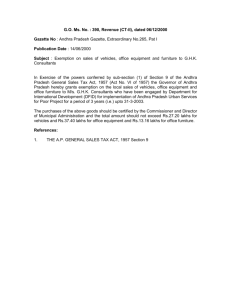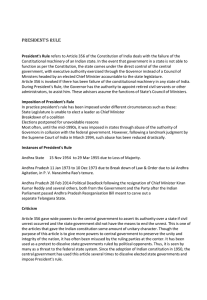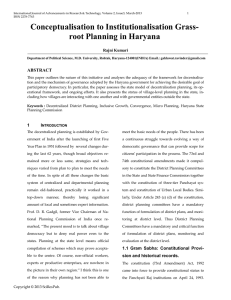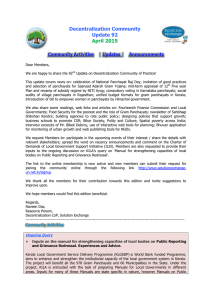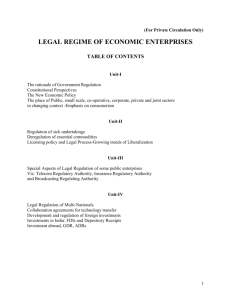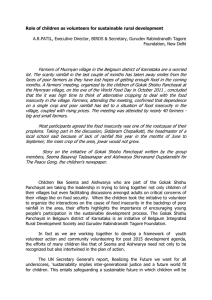Panchayts and Parallel Bodies in Andhra Pradesh
advertisement
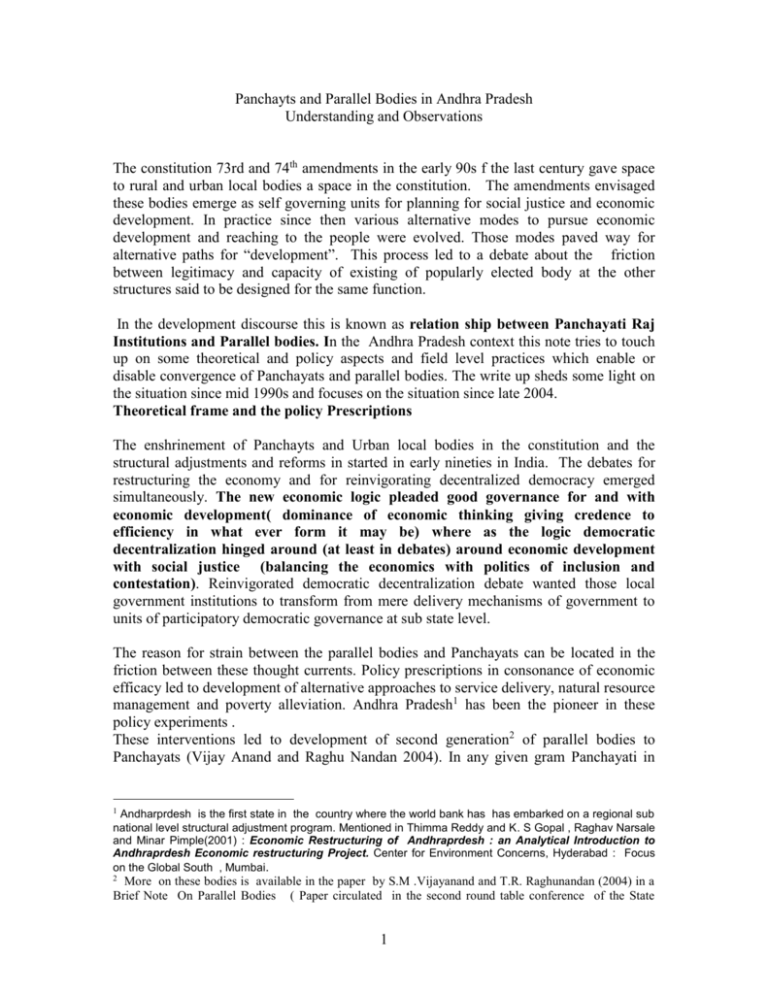
Panchayts and Parallel Bodies in Andhra Pradesh Understanding and Observations The constitution 73rd and 74th amendments in the early 90s f the last century gave space to rural and urban local bodies a space in the constitution. The amendments envisaged these bodies emerge as self governing units for planning for social justice and economic development. In practice since then various alternative modes to pursue economic development and reaching to the people were evolved. Those modes paved way for alternative paths for “development”. This process led to a debate about the friction between legitimacy and capacity of existing of popularly elected body at the other structures said to be designed for the same function. In the development discourse this is known as relation ship between Panchayati Raj Institutions and Parallel bodies. In the Andhra Pradesh context this note tries to touch up on some theoretical and policy aspects and field level practices which enable or disable convergence of Panchayats and parallel bodies. The write up sheds some light on the situation since mid 1990s and focuses on the situation since late 2004. Theoretical frame and the policy Prescriptions The enshrinement of Panchayts and Urban local bodies in the constitution and the structural adjustments and reforms in started in early nineties in India. The debates for restructuring the economy and for reinvigorating decentralized democracy emerged simultaneously. The new economic logic pleaded good governance for and with economic development( dominance of economic thinking giving credence to efficiency in what ever form it may be) where as the logic democratic decentralization hinged around (at least in debates) around economic development with social justice (balancing the economics with politics of inclusion and contestation). Reinvigorated democratic decentralization debate wanted those local government institutions to transform from mere delivery mechanisms of government to units of participatory democratic governance at sub state level. The reason for strain between the parallel bodies and Panchayats can be located in the friction between these thought currents. Policy prescriptions in consonance of economic efficacy led to development of alternative approaches to service delivery, natural resource management and poverty alleviation. Andhra Pradesh1 has been the pioneer in these policy experiments . These interventions led to development of second generation2 of parallel bodies to Panchayats (Vijay Anand and Raghu Nandan 2004). In any given gram Panchayati in 1 Andharprdesh is the first state in the country where the world bank has has embarked on a regional sub national level structural adjustment program. Mentioned in Thimma Reddy and K. S Gopal , Raghav Narsale and Minar Pimple(2001) : Economic Restructuring of Andhraprdesh : an Analytical Introduction to Andhraprdesh Economic restructuring Project. Center for Environment Concerns, Hyderabad : Focus on the Global South , Mumbai. 2 More on these bodies is available in the paper by S.M .Vijayanand and T.R. Raghunandan (2004) in a Brief Note On Parallel Bodies ( Paper circulated in the second round table conference of the State 1 Andhra Pradesh there are nearly ten parallel bodies comprising stake holders committees ,user groups , self help groups etc. Some of them had statutory backing Water Users Associations (WUA), School Educating Committees, (SEC) are examples of this variety. Other was creation of Government Orders like Vana Samrakshana Smiths or registered under society’s act like Women Self Help Groups. These bodies were supported as specialized agencies of various line departments for taking up specialized job. Sprouting and flourishing of these specialized bodies is also can be ascribed to the skepticism of policymakers and bureaucrats about the abilities of the local institutions. This skepticism appears to be a product of the rural reality of, illiteracy, poverty and caste ridden society. This was true of pre reform period in Andhra Pradesh too. The situation has not become better with a paradigmatic shift from state centric system to market orientation.3. The problem to a substantial extent lies in understanding of the local institutions as delivery mechanisms of higher echelons of government (Union and State). This approach did not change even after provision of constitutional space to them. The reforms pushed forward the argument of efficient delivery services and governing for results and emphasized the increase of the “stake holders”4 ( not citizens) in the development efforts. This move significantly reduced the scope, minimized chance for innovation, stunted the flourishing of panchayts in Andhraprdesh. Many a donor driven NGO activity since early 1990s also undermined the local bodies. They too cared less for these grassroots democratic institutions. In this context revitalizing them is a big challenge The irony is that many of these specialized bodies take up the tasks mentioned in the eleventh schedule which provided for a list of 29 subjects in which panchayts has to be given primacy(along with two higher level governments). Especially the areas which are crucial for human and natural resource management were de linked from the ambit of panchayts. Ones again the argument against panchayts hinged around inefficiency and lack of capacity. In fact Panchayats are sparingly capacitated compared to these parallel bodies. With the advent of this specialized body focus has shifted to build capacity of those stake holders than to the popularly elected bodies. Thus is the current state of marginalization of constitutionally mandated institutions for democratic decentralization. Scenario On the ground By late 2004 the Women’s self Help groups or (WSHGs), Water Users Associations, Vana Samrakshana Samithis and watershed committees (supported by District Water Management agency DWMA and other agencies)were in vogue with proper support. The Ministers of Panchayathi Raj held in Mysore in august 20004)- accsses from http://www.solutionexchange –un.net.in/decen/cr/res08030703.doc down loaded April 2007 3 G. Krisna Reddy in Governance reforms and development in Andharaprdesh: A view through rural prism in : Globalization , Governance reforms and Development in India Ed. Kameshwar Choudhary,2007 Sage,New delhi. 4 Mooij Jos ,2003, in smart governance? Politics in policy process in Andhraprdesh , India working paper no 228 , London , Overseas Development Institute 2 school education committees of previous statutory incarnations are done away with. These parallel bodies have enhanced stakeholders understanding of the scheme of things. General characteristics of P.Bs They are financially stronger than any average panchayts. For example any watershed committee of minimum 200 Ha would have finance resources of Rs.12 lakhs5 (GOI 2008) for a period of five years. They are accountable to small group of stake holders and the officials of line departments associated. They have exclusive focus on specific tasks as stake holders. For example many times the Village Organization (VO)–a body elected from small WSHs in the village feels that the business of thrift and credit is a private affair which need not be discussed at gramasabha. Many of these bodies are creatures of executive orders. They generally keep away from the function process of panchayats Reasons for conflict Parallel Bodies completely undermining the panchayts and function independently. The need and mandate for convergent action with PRIs is violated thus leading to duplication and pilferage. The exclusive patronage of technical support of the line departments to the parallel bodies associated with their activities. Sharing of the information and, resources and the results of the tasks is not taking place. This opaqueness leads to doubts and mis understanding . There is no organic link established between PBs and panchayats( Occassionallly there is a notional membership of sarpanch in some of these parallel bodies which in reality did not hold any substance) These characteristics keep the parallel bodies and panchayts in an unhappy relation. Field level efforts for convergence: Though the general policy climate is inimical to panchayats there are some positive practices are on the ground. Here are some cases from the field where there is convergence was achieved at functional level.. 5 Government of India 2008 Common Guidelines for watershed development Projects, reproduced by WASSAN in 2008. 3 Case –I SHG and Panchayats. In Anathema Grama Panchayat of Parvathagiri Mandal of Warangal district there is higher degree of convergence between the Panchayat and the Village level organization of Women Self Help Groups. It was achieved through understanding and rapport generated between the Sarpanch and the leaders of SHGs. This led to establishment of a water treatment plant with in the village by the women’s groups and now they are running with profit. The plant is governed by a committee in which one of the ward members is the committee member. Water is supplied to the plant from the panchayath and a building was constructed with general funds to house the water treatment equipment. And the committee reports its monthly activity to the Panchayat. This is a case of cooperation Case-II WUA and Gram Panchayth ( Cinna ramana Gari Palle) China Ramona Gari palle of Nallamada Mandal of Anantha puram is an example for convergence between the water users association and the Panchayat. The water users association closely worked with the Panchayt and farmers in the Panchayat decided to stop digging bore wells. Instead they started sharing of water from the existing 38 bore wells. The village tank is treated from the catchment to the command. Funds of WUA are used and the accounts are presented in the gramasabha. The water users association keeps all its accounts in public domain.The panchayth are working in close collaboration with water users association. Panchayat and WUA now prepare crop and water use plan for the village every year keeping the rainfall and water table level in view. This is a case of cooperation Case III. Establishing and strengthening functional relations between PRIs and VSSs: Experiences of SVRDES The main objective of the initiative is to facilitate convergence of VSSs and PRIs for effective and purposeful natural resource management and work towards building functional relationship between VSSs and PRIs. Both the institutions realized the need to converge and work towards effective management of natural resources. A series of meetings between these institutions helped to reach an understanding. Information sharing facilitated strengthening of relations. There was mutual trust and understanding which paved the way for smooth functioning of convergence . The above cases of functional convergence shows bring us to some pre requisites 4 Convergent efforts in the face of adverse policy environment Understanding the commonality of the mandate by the Panchayat and the parallel body. Information sharing among the institutions Sharing of the resources between and among the institutions What can be done at policy level? There are serious efforts at convergent action at the higher levels of the line departments concerned with holistic development with ministry of the panchayati raj. Committee system has to be strengthened at the Panchayat. Participatory planning for economic and social development by the panchayats and parallel bodies has to be mandated. Grama Sabha has to be strengthened and all the parallel bodies have to be made accountable to it. There should be a monthly convergence meeting of the general body of the Panchayat and the office bears of the parallel bodies. All the financial and work related records of the parallel bodies and the panchayats have to be kept in public domain. All the Operation and maintenance budgets for the structures developed by the parallel bodies have to be rooted through the panchayath. There is need for a concrete thinking around the principles of subsidiary, efficiency, democratization and citizens right full participation in decisions which affect them. 5
